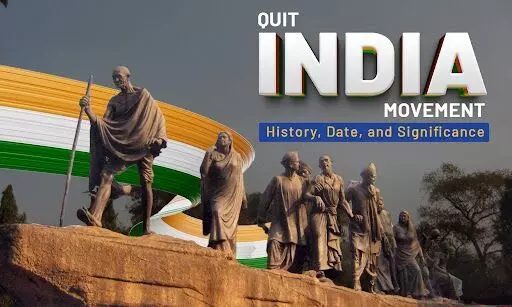Quit India Movement: History, Date, and Significance
Learn about the Quit India Movement and get to know its crucial role in India's independence struggle, its profound impact, and its legacy.
Quit India Movement: History, Date, and Significance

Quit India Movement Day, celebrated annually on August 9, marks a crucial moment in India's fight for freedom from British colonial rule. Known as August Kranti Day, this day commemorates the 81st anniversary of the Quit India Movement, a crucial phase in the Indian independence movement. Launched on August 8, 1942, during World War II, this movement represented a decisive step toward ending the British Raj and achieving Swaraj (self-rule).
The Genesis of the Quit India Movement
The Quit India Movement, or 1942 Quit India Movement, was orchestrated by the Indian National Congress with the support of Mahatma Gandhi, who was a central figure in this civil disobedience movement. The backdrop of the movement was marked by escalating tensions due to World War II and the failure of the Cripps Mission, which was an attempt by the British government to secure Indian support for the war effort by promising self-government post-war.
The All India Congress Committee convened at the Bombay session of Congress in August 1942, where the Quit India resolution was passed. This resolution demanded an immediate end to British colonial rule in India and was a bold declaration of the Indian people's resolve to seek independence. The movement was characterized by widespread strikes, protests, and demonstrations across the country, symbolizing a unified push for freedom.
Mahatma Gandhi's Role and the Iconic Speech
The Quit India Movement was launched with a powerful speech by Mahatma Gandhi, famously known as the Mahatma Gandhi Quit India speech. In his address, Gandhi called for non-violent resistance against British rule, encapsulated in his slogan “Do or Die.” This speech not only motivated millions to join the struggle but also emphasized the commitment to achieving freedom through non-violent resistance.
Gandhi's speech was delivered during the Bombay session of Congress, where he urged Indians to engage in civil disobedience and non-cooperation with the British authorities. His call to action was a significant moment in the Indian independence movement, galvanizing the masses and setting the stage for a large-scale uprising against the British Raj.
Significance of the Quit India Movement
The Quit India Movement significance extends beyond its immediate impact. While the movement did not achieve its goal of ending British rule immediately, it played a crucial role in intensifying the struggle for independence. The movement's impact was felt through the widespread civil disobedience and the growing realization among Indians of the need for self-rule.
The movement also highlighted the role of Indian freedom fighters and the sacrifices they made. It marked a turning point in India's freedom struggle by bringing together various factions and unifying them under a common cause. The Quit India Movement was a testament to the Indian people's determination and resilience in the face of colonial oppression.
Legacy and Commemoration
Every year, Quit India Day is observed on August 9 to honor the legacy of the Quit India Movement. This day serves as a reminder of the courage and determination of those who participated in the struggle against British colonial rule. The anniversary is a time for reflection on the historical events that shaped India's path to independence and a celebration of the achievements of the Indian independence movement.
The Quit India Movement also holds a special place in the narrative of India's journey towards sovereignty. It is remembered as a symbol of the collective will of the Indian people to challenge and dismantle the British Raj. The movement's legacy continues to inspire new generations in India, emphasizing the values of perseverance and patriotism.
The Quit India Movement in Historical Context
The Quit India Movement occurred against the backdrop of several other significant historical events in India. The failure of the Cripps Mission and the ongoing World War II created a sense of urgency among Indian leaders to push for immediate independence. The movement was part of a broader strategy to end British colonial rule in India and to establish a sovereign state.
The Quit India Movement was not an isolated event but a continuation of the civil disobedience movement that had been gaining momentum since the early 20th century. The movement built on previous efforts, including the non-cooperation movement led by Gandhi and the earlier struggles for self-rule. The Quit India Movement was also a response to the British government’s attempts to prolong colonial rule and delay the granting of independence.
The Quit India Movement remains a defining moment in India's history, marking a critical juncture in the country's struggle for freedom. Observed annually as Quit India Day, it serves as a tribute to the courage of the Indian people and their relentless pursuit of independence. The movement’s legacy continues to resonate, reminding us of the enduring spirit of resistance and the quest for self-determination that characterized the fight against British colonial rule in India.

